
Vol. IX, No. 9, October / November 2009
- Editor's travelogue: my round-the-world trip
- IAAPA Attractions Expo, November 16-20
- Did entertainment spending really grow in 2008?
- Customized cookies, baked in 2 minutes
- Mass customization in Vietnam
- Attractive female staff could be bad for business
- HOOTERS opens its 1st bowling center
- BellaBoo's gets great reviews
- Soft-modular-play on wheels
- Quarter results for two location-based entertainment chains
- Skee-Ball celebrates 100th anniversary
- Families' favorite restaurants
- Upcoming presentations
Editor's travelogue: my round-the-world trip
Learn about Randy White's two-week round-the-word trip to Hanoi, Vietnam; Doha, Qatar and Nicosia, Cyprus
As promised, here’s a report on my round-the-world trip with stops in Hanoi, Vietnam; Doha, Qatar; and Nicosia, Cyprus. Around-the-world air travel is not as expensive as you might think. Most airlines, with their alliance partners, offer special round-the-world airfares, about $2,000-$2,800 for coach and $8,000-$10,000 for business class. You can generally take up to a year to complete the trip and make multiple stops. The one firm rule is you have to keeping going in the same direction, either west or east. You can’t backtrack to a destination in the opposite direction.
Back in 2000, I did a round-the-world trip, stopping in Casablanca, Morocco; Dubai, U.A.E.; Mumbai, India; Bangkok, Thailand; Hong Kong and Hawaii. That trip was west to east and took three weeks. This time I traveled east to west over two weeks. Either direction, you have to deal with serious time zone differences. For example, Hanoi was 12 hours later than Kansas City, Missouri, where I live.
Before I get into the trip details, you may wonder how you pack for a two-week multi-stop trip. There are several things you learn the hard way if you travel a lot internationally. One is if your checked luggage gets lost, you probably won’t see it for at least three days -- if you’re lucky. I pack four days’ clothing in my carry-on, plus all essentials you couldn’t easily replace. The four days’ clothing should be what you will need for your first four days. Then everything else, this time 10+ days’ worth of clothing, goes into the checked bag. Then there is the computer bag you carry on with all the electronics for different electric systems and all important business papers you couldn’t do without for the entire trip. Here’s what it looked like before I headed off to the airport.
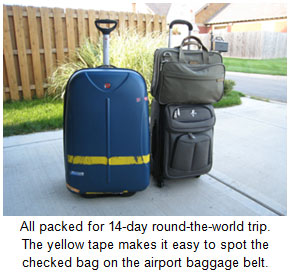
By the way, there was still some spare room in the checked bag for some things I bought on the trip such as spices from the souk in Doha, Qatar ($2 a pound for great cinnamon sticks, tasty Iranian raisins and Arab dates I can never resist).
The airlines I flew were quite an assortment. Here they are in order:
- Midwest Airlines to Seattle, Washington
- Asiana Airlines to Hanoi via Seoul, Korea
- Thai Airways to Bangkok, Thailand
- Oman Air to Doha via Muscat, Oman
- Gulf Air to Cyprus via Bahrain
- Cyprus Airlines to Amsterdam, Netherlands
- Northwest Airlines to Kansas City, Missouri, via Minneapolis, Minnesota
Traveling west across the International Dateline can pose a mental challenge. As you know, when you travel west through time zones, it gets earlier. For example, the time in Los Angeles is two hours earlier than Chicago. My trip to Hanoi took a total of 24 hours and I traveled west across 12 time zones. I left Kansas City, Missouri, at 9:50 a.m. Thursday. Did I gain time by traveling west? No, instead I arrived in Hanoi at 9:50 p.m. Friday, 36 hours later. So in effect, I lost a day. But I regained it when I flew home. Confusing? Sometimes it’s not worth the mental challenge to keep it all straight. So I have a special clock on my computer that shows the time and day in various cities.
Hanoi, Vietnam
The first thing that strikes you about Hanoi is the traffic, the sea of motor bikes and motor scooters and the far fewer cars, buses and trucks traveling with them inches apart. Stop at intersections? No way! Everyone just keeps coming from all directions, both going straight and making turns. They just mysteriously manage to weave past each other and not collide. It’s sort of like different schools of fish intersecting and somehow continuing to move in mass without colliding.
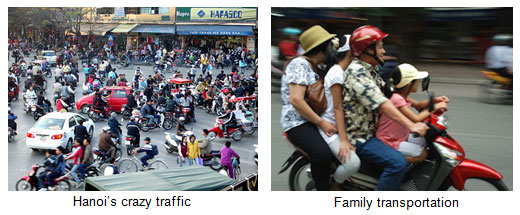
The best I can figure, the only rules of the road are: Don’t hit anyone, and don’t let anyone hit you. Here’s a half-minute video that captures the organized chaos. Click here to see video. Actually, to Westerners it may seem crazy, but to the Vietnamese, it’s just their system. Every culture has solutions to problems, and Vietnam’s solution for driving is different than ours in the West -- but it works for them, and that is all that really matters. So what is “crazy” depends on your perspective. One cultural solution isn’t necessarily better than another, as long as it works for the people involved.
The Vietnamese economy is growing rapidly, and Hanoi is expanding. No matter what street you drive down, the ground floor of every building is some sort of independently owned shop. Early generation malls and national brand stores are just starting to show up. But the real shopping experience is found in the 1000-year-old Old Quarter with its very narrow streets. The Old Quarter was formed in 1010 when King Lý Thái Tổ decided Hanoi, which was then called Thăng Long (Soaring Dragon), would became Vietnam’s capital. Although the Old Quarter is often called “the 36 old streets,” there may have actually been more. Most of the street names start with “Hàng,” which means “shop,” and the next word would be a name of a product for sale. For example, “Hàng Bạc” was a street where silver products were sold, and “Hàng Bông” was a street where you could by cotton products.
I found Hanoi to be a very interesting city. It is Asian, but its culture has its own uniqueness and character, different than neighboring China and Thailand. Its people are incredibly friendly. The city is a little rough around the edges, but it is truly authentic and quickly grows on you. You have to wonder why the U.S. fought a war against the Communists in the north of the country where Hanoi is located, when the Communist system with its eight-year-old market economy hasn’t turned out all that bad. In fact, the prosperity of its people is constantly improving. The Gross Domestic Product is growing at around 7% a year. I have no hesitation about returning and in fact look forward to the opportunity.
From Hanoi it was off to Doha, Qatar, in the Middle East where I have been going for 10 years and where we have a branch office. Qatar has rapidly grown over the last decade, supported by its wealth mainly in natural gas. When I first went to Doha, it was a quiet city of about 500,000 people with only two Western-style hotels and probably no building over about 10 floors. It was pure Middle Eastern. Since then, the city has been almost completely rebuilt and has expanded beyond what anyone could have forecast 10 years ago. Today, expats out number citizens by about 3-to-1 with a population in excess of 1 million. Every time I go, new towers have been built that weren’t there the last trip. Hundreds more are planned.
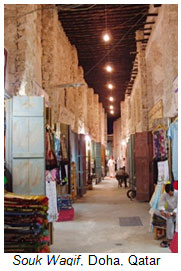 Remember that extra room in my luggage? Well, it got filled up with spice, apricot and raisin purchases at Souk Waqif, a Doha souk that has been meticulously restored to its original condition. And while in the souk, we went to the Al Adhamiyah Iraqi Restaurant for authentic Iraqi food. That is one of the wonderful things about hopping from one country to another. Not only does the culture change, but also the cuisine. Other restaurants I have enjoyed in Doha feature Iranian, Pakistani and original Qatari foods. And then there are what I call the drive-up shops for falafel and other original Middle Eastern foods (sort of their equivalent of fast food) and cocktails, what Qataris call their fresh fruit drinks. Ever tried an avocado drink? I may not sound good, but try one and you’ll be a fan for life. By drive-up, I mean you park in front of or near a small street-front shop. You might even double park in the street, honk your horn, and someone comes running out and takes your order. And presto, they bring it out for you to eat in your car or to take home. Drive-up in many ways works far better than American drive-thrus.. Just a different culture’s solution to a common problem.
Remember that extra room in my luggage? Well, it got filled up with spice, apricot and raisin purchases at Souk Waqif, a Doha souk that has been meticulously restored to its original condition. And while in the souk, we went to the Al Adhamiyah Iraqi Restaurant for authentic Iraqi food. That is one of the wonderful things about hopping from one country to another. Not only does the culture change, but also the cuisine. Other restaurants I have enjoyed in Doha feature Iranian, Pakistani and original Qatari foods. And then there are what I call the drive-up shops for falafel and other original Middle Eastern foods (sort of their equivalent of fast food) and cocktails, what Qataris call their fresh fruit drinks. Ever tried an avocado drink? I may not sound good, but try one and you’ll be a fan for life. By drive-up, I mean you park in front of or near a small street-front shop. You might even double park in the street, honk your horn, and someone comes running out and takes your order. And presto, they bring it out for you to eat in your car or to take home. Drive-up in many ways works far better than American drive-thrus.. Just a different culture’s solution to a common problem.
Then it was off to Nicosia (Lafkosia), Cyprus where I spent four days. Cyprus is a island just south of Turkey and a little west of Lebanon. In a sense, it is really two countries. In 1974 the Turkish Army invaded and took over control of the northern part of the country. The south is a presidential-republic type democracy. The north and south are divided by a United Nation’s controlled Green Zone that cuts right through Nicosia and the Old Town part of Nicosia that is within the Venetian rampart walls build in 1570. There has since been some sort of agreement between the north and south for unified government, but the north has never sent its delegates to take part in the House of Representatives. Since 2004, check points have been opened up to cross between the north and the south, but you better bring your passport if you want to get back into the south.
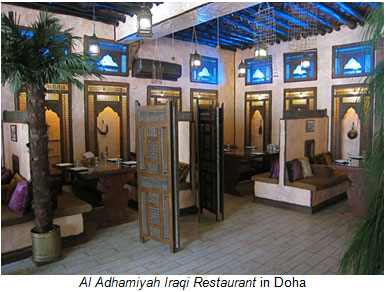
The culture was originally Greek, but my observation is it has evolved as a unique Cyprian culture with Greek and European influences. Be warned about the food: delicious and tons of it. The expression is Cypriots eat like they are going to die tomorrow. What is called a meze meal is sort of like Spanish tapas. However, with meze, the different dishes never stop coming, or at least it seemed that way. Did I say stuffed?
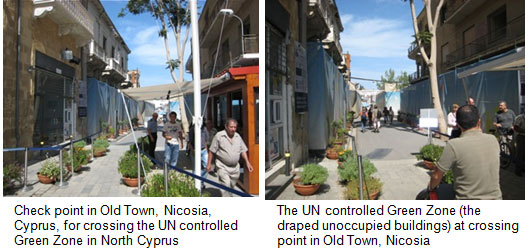
From a U.S. perspective, I thought they also drive a little crazy. First they drive on the left, due to the original British occupation. All the roads and highways, even the lanes on the new expressways, are narrow. The Cypriots zip around in their not necessarily small cars at a high rate of a speed and just inches apart. But then again, it seems to work for them. Unlike in Hanoi, in Cyprus they give pedestrians the absolute right-of-way, rather than just speeding around them. Again, it’s all in your cultural perspective. When Cypriots come to the United States, they probably think Americans are crazy to drive such large vehicles and waste so much land and money building wide roads with lanes on the sides of expressways (the shoulder lanes) that never get used.
So that’s a synopsis of my round-the-world journey. Since the trip, we have completed a master plan for our Hanoi client for a 3-million-square-foot mixed-use urban project that includes a 750,000-square-foot mall with over 220,000-square-feet of entertainment, edutainment and cultural attractions; office towers; a hotel; four residence towers and a several-acre outdoor park that includes entertainment attractions. We’re also working on a number of other projects, including a hybrid bowling center, an new agritainment (agri-tourism) project and a new whitespace project that might best be described as transform-tainment, an entertaining attraction of transformational experiences.
I’m pleased to let you know I was selected to be on the Harvard Business Review’s Advisory Council.

 You can stay current on our projects as well as many news items we don’t include in our monthly/bi-monthly Leisure eNewsletters by following me on Twitter. It’s easy to sign up for Twitter. Lots of famous people and national companies regularly post there. Even Sophia, our office mascot, likes to check out my tweets.
You can stay current on our projects as well as many news items we don’t include in our monthly/bi-monthly Leisure eNewsletters by following me on Twitter. It’s easy to sign up for Twitter. Lots of famous people and national companies regularly post there. Even Sophia, our office mascot, likes to check out my tweets.
Randy White
Editor
Vol. IX, No. 9, October / November 2009
- Editor's travelogue: my round-the-world trip
- IAAPA Attractions Expo, November 16-20
- Did entertainment spending really grow in 2008?
- Customized cookies, baked in 2 minutes
- Mass customization in Vietnam
- Attractive female staff could be bad for business
- HOOTERS opens its 1st bowling center
- BellaBoo's gets great reviews
- Soft-modular-play on wheels
- Quarter results for two location-based entertainment chains
- Skee-Ball celebrates 100th anniversary
- Families' favorite restaurants
- Upcoming presentations


